Book Appointment
Fillup the form to make an appointment with the doctor
Health Professionals Knee Arthritis & Medical Management
There has been tremendous effort done in the last 3-4 decades to improve the quality of life for patients who have arthritis. There are a lot of studies looking into various facets of arthritis management which has changed the present management scenario in arthritis. Unfortunately, there has been a significant effort to market questionable practices and sometimes outright dubious treatment as being useful in the management of Osteoarthritis.
We will focus our discussion about the present consensus in the management of OA knee. The algorithm mentioned below will act as a guide in the management of OA knee. There is a mild correlation with the radiological appearance of a joint and the clinical findings in a patient. A patient with severe degeneration might have minimal complaints, while patients with mild to moderate degeneration radiologically can have severe symptoms. Ultimately, your doctor will decide the treatment based on your symptoms and X-rays.
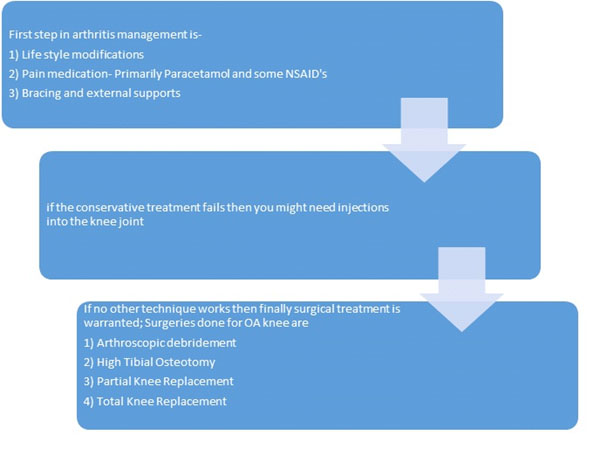
There are strong recommendations regarding the advantage of exercise in managing OA knee symptoms. One must continue to exercise in OA knee and aim to maintain a BMI of < 25. Weight reduction is an essential component of OA knee management. Smoking is known to accelerate knee degeneration, and it is advisable to quit smoking to prevent further damage to the cartilage.
It is advisable to avoid specific exercises like long-distance running, pounding on the knee, skipping, jumping to prevent damage to the cartilage. Otherwise, it is perfectly reasonable for a patient to go jogging, swimming, cross trainer, cycling to maintain a healthy lifestyle. The table below mentions the number of calories burnt during certain activities by a 70 kg adult.
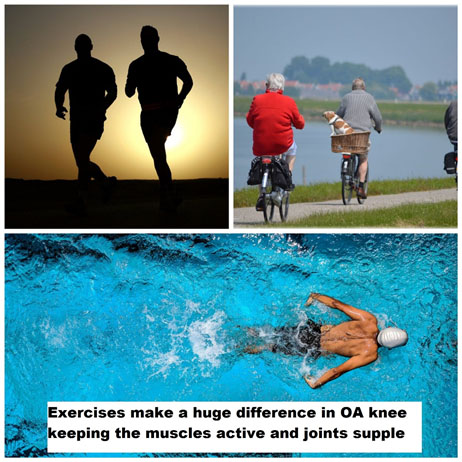
| ACTIVITY(1-hour duration) | CALORIES BURNT |
|---|---|
| Walking at 3.5 km/hour | 200-225 Kcal |
| Jogging at 8 km/hour | 500 Kcal |
| Cycling at leisure | 300 Kcal |
| Swimming | 450 Kcal |
It is a common query, and the answer is a resounding yes. An obese individual must follow an exercise regimen that helps in losing weight and thereby reduce the final stresses on the knee joint.
In the lay press and in “advertorials” one gets to hear and see a lot of stuff about “magic” remedies for OA knee. Currently, there are very few Disease-Modifying Oral Anti OA knee Drugs. Most medications only manage pain in arthritis.
There are a large number of medications, dietary supplements, and even herbal remedies marketed as cures for OA knee. Unfortunately, we do not have functional quality studies that have looked into the claims, and some could be potentially dangerous. Glucosamine, Chondroitin sulfate, Diacerein, S-Adenosyl-L-Methionine (SAM) are medications tried in the past for OA knee.
Glucosamine and Chondroitin have been in the market for an extended period. Their usage is no better than the placebo (Apparent benefit that is more psychological than actual effect by the drugs themselves). Most studies advocating their usage are animal studies, and there are few independent randomized controlled trials. The cost of care would be about 25-30 rupees a day, and you will have to weigh the benefit from the price before continuing to take them.
At the outset, we would like to tell you that this is an attempt to put in perspective the available Ayurvedic and herbal medications in the market that are helpful in the management of knee arthritis symptoms. Herbal ingredients have been proven to be beneficial in some studies, and one has to weigh the risk benefits before starting them. The patients must make an informed choice about the manufacture of those products from reputed companies so that they do not have any toxic byproducts in them. There have been instances where contaminated herbal medications have resulted in life-threatening complications.
Curcumin (Present in turmeric) and Resveratrol (present in grapes, peanuts, and wine) are known to have potential anti-inflammatory properties and traditionally used in OA knee management in ancient medicine.
Boswellia Serrata( Shallaki) This is a herbal remedy that has been used in Ayurveda for ages for arthritis. Recent studies have shown to have efficacy in the relief of pain.
Avacado Soyabean unsaponified ( ASU) ( Neerbhij) This is a combination of extracts from Avacado and Soyabean, which is useful in the treatment of OA symptoms. Randomized controlled trials have shown that there is a superior to the placebo effect with this treatment. ASU has been known to inhibit the interleukin pathway (basically inflammation-causing mediators in the knee joint) and thus relieves pain in arthritis.
Ginger( zingiber officianale)- This is a common ingredient in Indian cooking and is known to have an anti-inflammatory effect and gives relief of pain in OA knee.
| HERBAL FORMULATION | SIDE EFFECT |
|---|---|
| Boswellia serrata (shalaki, salei guggul) | None known |
| Curcuma Longa(turmeric ) | GI disturbances, animal studies thyroid disorders |
| Capsaicin | Redness and burning |
| Harpagophytum procumbens (Devil’s claw) | GI upset |
| Zingiber officiniale ( Ginger) | Mild heartburn and GI upset |
| Poplar (American aspen) | Asthma, Contact dermatitis, GI bleeding, liver, renal dysfunction, and ringing in the ear |
| Willow bark ( Salix alba, S.Purpurea, and S.Fragilis) | Nausea, Headache and GI upset |
There are various physical therapy modalities one employs in the treatment of OA knee. The PT modalities are employed so that the associated swelling, weakness, blood circulation are addressed. There is presently no standard guidelines for using PT in the treatment of OA knee. Some studies have shown the Ultrasound to be more effective than other modalities like Nerve Stimulation, Short wave diathermy, Interferential therapy, and Wax bath. If you find benefit from these modalities of treatment, then it is worthwhile to continue them.
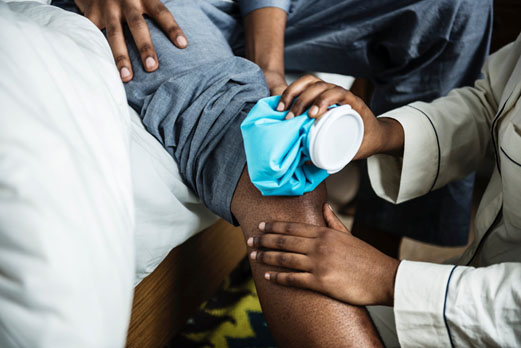
Certain braces have been designed to take the weight transmission axis away from the worn-out inner compartment to the relatively healthy outer compartment of the knee joint (lateral compartment). As a stop-gap arrangement, these braces help to manage knee arthritis. But, ultimately when the symptoms are persistent even after their usage (for more than one month), then there is a minimal chance that it will benefit you for your arthritis.
The strength of recommendation was 76% for off-loader braces’ ability to support unstable osteoarthritis knees according to the Osteoarthritis Research society international.
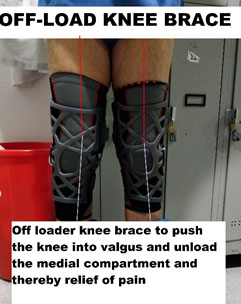
Many good quality braces start from 5-10,000 rupee range, and they can go up to 30,000 rupees. Some excellent Indian companies have started making such braces that are available on an online platform like amazon and Flipkart.
Ramsey, Dan K., and Mary E. Russell. “Unloader Braces for Medial Compartment Knee Osteoarthritis: Implications on Mediating Progression.” Sports Health 1.5 (2009): 416–426. PMC. Web. 17 Feb. 2018.
Heel insole wedges for OA knee have been tried, and they have found to have some benefit in the management of early OA knee. But, overall the scientific evidence is inconclusive, or many guidelines agency recommend against using the lateral wedge insole.
| ADVANTAGES | DISADVANTAGES |
|---|---|
| Minimal cost | Can be a cause of some discomfort with irritation in the feet |
| Can be used in most footwear | |
| No side effects |
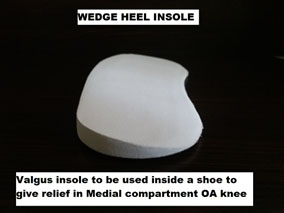
Parkes, Matthew J. et al. “Lateral Wedge Insoles as a Conservative Treatment for Pain in Patients With Medial Knee Osteoarthritis: A Meta-Analysis.” JAMA310.7 (2013): 722–730. PMC. Web. 20 Feb. 2018.
Duivenvoorden, Tijs et al. “Do Laterally Wedged Insoles or Valgus Braces Unload the Medial Compartment of the Knee in Patients With Osteoarthritis?” Clinical Orthopaedics and Related Research, 473.1 (2015): 265–274. PMC. Web. 20 Feb. 2018.
We recommend that if a patient is not finding benefit from simple pharmacological methods, then there is no harm in trying a heel wedge. Many times there is short term symptomatic relief with these insoles even though extensive studies do not show much benefit.
There are broadly three categories of medications that have been tried in the knee joint by injections Steroids, Visco supplements, and Platelet Rich Plasma. Firstly, Steroids have been used for a long time and have known to give relief of pain. Steroids are the cheapest of all three options. They have potent anti-inflammatory action and are known to provide short term relief. Unfortunately, studies have found that the rate of cartilage damage increases with prolonged steroid usage. There is a risk of infection, also when the steroid is injected esp. in patients with Diabetes and Renal failure. The indications for steroid use is selective in an elderly patient. An arthritis flare, inability to perform a basic activity and not being a candidate for joint replacement are indications for steroid injections.
Visco supplements are necessarily lubricants that are injected into the joints and thereby help in the relief of pain symptoms. The active ingredient is “Hyaluronic acid,” which is a natural constituent present inside a joint. Extensive trials have shown that they are either marginally effective or ineffective in meaningfully relieving of pain in OA knee. The other significant point one has to consider when opting for this method is the cost involved in the care which might typically be in the range of 15-20,000 rupees for a single injection.
Richette P, Chevalier X, Ea HK On behalf of the French OsteoArthritis study group, et al. Hyaluronan for knee osteoarthritis: an updated meta-analysis of trials with low risk of bias RMD Open 2015;1:e000071. DOI: 10.1136/rmdopen-2015-000071
PRP is a new concept where platelets, the cells that are responsible for clotting of blood, which are harvested from blood with plasma, and the combination injected into the knee joint. The anti-inflammatory property of the activated platelets has been known to give some relief from pain. The cost is intermediate between steroids and Visco-supplements. Many studies have shown that PRP is better than visco-supplements in the treatment of early arthritis. The present consensus is that PRP is better than hyaluronic acid. The PRP itself should be appropriately prepared with an adequate concentration of platelets for it to be effective in OA knee management.
Broadly three categories of oral pain medication are advised in the management of OA knee- Paracetamol, NSAID’s and Tramadol even though there are other medications. These three groups of drugs are the mainstay in treating pain in OA knee.
Paracetamol is safe, over the counter pain medication which, when taken at an appropriate dosage, can form the mainstay in treating long term pain due to OA Knee. It does not have the side effect profile of other NSAID’s like Ulcer of stomach and Kidney damage. Adults who weigh around 70 Kg can safely take up to 4 gm of paracetamol in a day. Ideally, it is wise to restrict to about 2-2.5 gm per day, which makes it 650mg tablets taken four times a day. Paracetamol can be extremely dangerous if it exceeds the 8 gm dosage in a day as it can cause massive liver damage. Paracetamol can be safely taken for weeks to months with minimal increase in risk.
NSAID- This is a heterogeneous group of pain medications. It consists of drugs like diclofenac, Aceclofenac, Ibuprofen, Meloxicam, Piroxicam, Etoricoxib. They vary in their action and side effect profile. They are useful in relieving pain, and their effect, in general, will last from 8-12 hours. Taken over a prolonged period when the cumulative dosage reaches around 3-4 Kg, which can be surprisingly reached by taking for a few months leads to irreversible kidney damage. NSAID’s are prescribed for days to a week or when there is a sudden increase in pain when other medicines are not sufficient. COX-2 inhibitors like Etoricoxib were developed for a decrease in gastric side effects, but unfortunately, they still have renal side effects.
Tramadol- This is a drug that acts in a different mechanism than the above two groups and helps in relief of pain. Tramadol can be taken for weeks to months at an appropriate dosage with a reasonable safety profile. Even though the maximum dosage recommended is 400mg per day, it is advisable to restrict to around 150mg per day. Side effect includes nausea, vomiting, lightheadedness, constipation. It has to be used with caution in a patient with a seizure disorder. Tramadol is available in combination with paracetamol for chronic pain like OA and back pain.
Only paracetamol is over the counter drug, which can be self medicated. Other medications have to be taken only by the prescription of a doctor, and a doctor must tailor the dosage to your symptoms. The need for long term medications increase the side effects.
Most topical treatment for OA Knee has an NSAID’s (Which are pain medications) and Capsaicin (which is present in the standard chili we use!) block the local pain fibers and help in the relief of pain in OA knee. It is safe to use them for an extended period, but some people can develop rashes and skin allergy to using topical rubs. They come in a wide variety of claims, and it is better to use judgment in picking the right one. As it could lead to significant cost savings if one uses a simple over the counter medication.